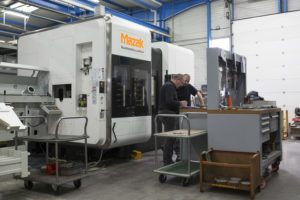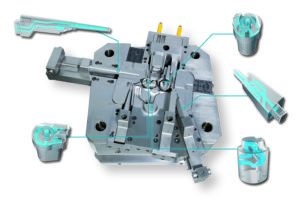Additive Manufacturing technologies allow die casting foundries to open up new business opportunities and to develop additional technology competencies. The market for additive manufacturing is growing very fast and strongly worldwide in various different areas and applications. Key markets include the aerospace industry, health care including medical technology and the automotive industry. Thus, additive manufacturing holds great potential also for die casting foundries.

(Source: Frank Druckguss, Georg Frank GmbH, Heilbronn, Germany)
“Additive Manufacturing” (AM), which emerged from the “rapid prototyping” technology of the 1980s, has become an indispensable part of production technology and a huge market as well. The providers of AM technology are working to increase system performance, to make processes more efficient, and to develop other materials suitable for these processes also known as “3D printing”. Their principle is to convert the data of a virtual workpiece with a 3D printer into a real workpiece. According to the 3D CAD data, a usually powdery material is deposited so that the workpiece progressively takes the desired shape. One method is “Selective Laser Melting” (SLM), in which a 20 to 40 μm thick layer of metal powder is applied to a lowerable worktop and melted by a laserbeam under protective gas at locations corresponding to the workpiece contours. During cooling, these sites solidify. The process is repeated many times. After each processing step, the worktop is lowered a bit further, so that layer by layer the workpiece is generated. The shaping thus is realized by adding material layers. As a material, various metals and plastic materials are offered.
Strengths and limitations
The strengths of additive manufacturing processes are particularly obvious when it comes to individual parts or small series with low material usage. It is possible to produce workpieces that are difficult or impossible to manufacture in the traditional way, for example by forging, casting or machining (“subtractive”) processes, such as parts with complex geometry, undercuts, cavities and internal structures. It is also possible to vary the wall thicknesses and thus to reduce the amount of material – and, as a consequence, also the weight of the finished part. Another advantage is that no tools are needed. However, the application of additive methods requires a relatively large amount of time and energy. Furthermore, the process-related structure of layer lines affects the surface quality of the finished parts, which generally also have to be reworked, for example, in order to remove the support structures from the workplate.
Die casting foundries and additive manufacturing technologies
Additive processes are already used in the field of foundry technology. However, due to the time required by them and cost comparisons these processes are not expected to compete with die casting or other casting processes in the foreseeable future. Dr.-Ing. Ioannis Ioannidis, Managing Director of die casting machine manufacturing company Oskar Frech and member of the board of the additive manufacturing working group of the German Engineering Federation (VDMA), believes that for die casting foundries additive technologies are a useful addition in order to offer services and achieve a business expansion [6]. By means of additive processes, prototypes of die castings can be produced relatively quickly (Fig. 1) and optimized, if necessary. In this way, development times, which are needed for the production of die casting molds, are reduced. In addition, a die casting foundry can use such prototypes to discuss with a customer in which way a die casting, which is to be manufactured, can still be optimized. Design changes can also quickly be realized. Additive processes also have great advantages with regard to die casting molds. Die casting molds or parts of them, such as cores and slides, need to be cooled in order that the die castings solidify as fast as possible. This has a positive impact on their quality and economy. Furthermore, the molds are not exposed to excessive thermal stress. The heat is dissipated via channels, which are incorporated into the molds near the surface and have the task of conducting the cooling media. Additive processes can be used to make casting molds or their inserts with ideally placed and shaped cooling channels. For example, the company Frech has been using an own SLM system for many years to manufacture prototypes and inserts for die casting molds with contour-aligned cooling channels made of an aluminium alloy (Fig. 2). It is also possible to manufacture individually spare parts that are rarely requested.

(Source:Oskar Frech GmbH & Co. KG, Schorndorf, Germany)
Die casting foundries, which use additive manufacturing processes, can open up new business fields and acquire additional competencies, depending on these processes and their characteristics in view of process and materials technology. Amomg other things, these processes are suitable for the manufacture of parts which are no longer available, for example oldtimer spare parts, and components for the aerospace industry, medical technology, the automotive industry and for motorsports. Dr. Ioannidis is convinced that there are many advantages “if one masters additive manufacturing technologies in an intelligent manner”.



